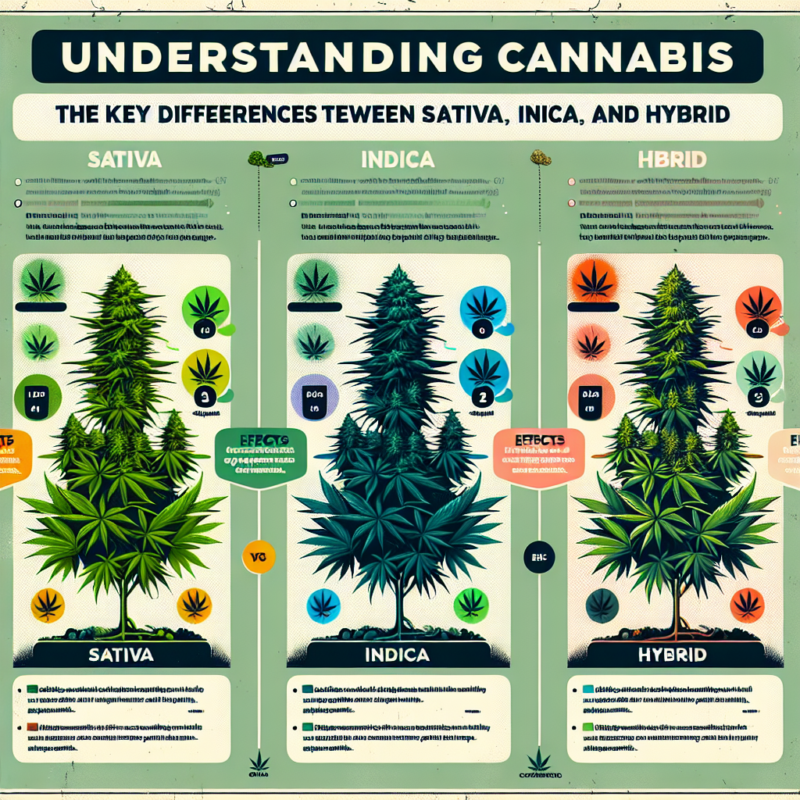Understanding Cannabis: The Key Differences Between Sativa, Indica, and Hybrid
In recent years, cannabis has made its way into mainstream culture, shifting from a once-taboo subject to a celebrated topic of discussion, especially due to its therapeutic uses and decriminalization in various regions. However, for many newcomers, the world of cannabis can be confusing—especially when it comes to understanding the differences between sativa, indica, and hybrid strains. This article aims to demystify these categories and provide insights into their distinct effects, characteristics, and uses.
The Basics of Cannabis
Cannabis is a plant that comes in three primary varieties: Cannabis sativa, Cannabis indica, and Cannabis ruderalis. The most commonly discussed strains belong to the sativa and indica categories, with hybrids being a blend of both. Each type has unique characteristics and uses, influenced by their genetic makeup.
Cannabis Sativa
-
Origins and Characteristics: Sativa strains are typically found in warmer climates and have been cultivated for their tall stature, narrow leaves, and longer flowering cycles. They generally thrive in equatorial regions.
-
Effects: Sativa strains are often associated with uplifting and energizing effects. Many users report feelings of euphoria, creativity, and increased focus. These strains are often favored for social situations or creative endeavors. They can stimulate the mind and promote an active experience.
- Medical Uses: Sativa strains are frequently sought after for their potential to relieve symptoms such as depression, anxiety, fatigue, and attention disorders. They can also provide relief from chronic pain without the heavy sedative effects often associated with indica strains.
Cannabis Indica
-
Origins and Characteristics: Indica strains are typically native to cooler climates and feature broader leaves, shorter plants, and a faster flowering time. Originating from regions such as the Hindu Kush mountains, these plants are often bushy and stout.
-
Effects: Indica strains are renowned for their calming and relaxing effects. Users often describe a sense of deep relaxation, making these strains ideal for winding down after a long day or for use in the evening. Indicas are commonly associated with a "body high," where physical relaxation can lead to drowsiness.
- Medical Uses: Indica strains are often chosen for their therapeutic benefits, particularly in addressing issues like chronic pain, insomnia, muscle spasms, and stress. Their sedative properties make them ideal for nighttime use or for those dealing with sleep disorders.
Hybrid Strains
-
Origins and Characteristics: Hybrid strains result from crossbreeding between sativa and indica plants, combining traits from both. This blend can yield a wide variety of effects, depending on the specific genetics and ratios of sativa to indica.
-
Effects: The effects of hybrid strains can vary significantly but are generally designed to offer a balance between the energizing effects of sativas and the relaxing properties of indicas. Some hybrids are indica-dominant, leaning more towards calming effects, while others may be sativa-dominant, producing uplifting sensations.
- Medical Uses: Hybrids are incredibly versatile and can be tailored to assist with a wide range of conditions, depending on their genetic lineage. They can be perfect for those seeking specific effects or medicinal benefits without the extreme sedation of an indica or the high energy of a sativa.
Choosing the Right Strain
When selecting a cannabis strain, it’s crucial to consider the intended use and personal preferences. Here are some tips for choosing the right strain:
-
Consider Your Goals: Are you looking for relief from anxiety, a boost in creativity, or help with sleep? Identifying your primary goals can guide your choice between sativa, indica, or hybrid strains.
-
Check THC and CBD Levels: Cannabis strains also differ in their cannabinoid profiles, mainly THC (tetrahydrocannabinol) and CBD (cannabidiol). High-THC strains will produce more psychoactive effects, while high-CBD strains are non-intoxicating and can provide therapeutic benefits without the high.
- Experiment and Document: Every individual reacts differently to cannabis. What works wonderfully for one person may not have the same effect on another. Experiment with moderate dosages and take notes on your experiences to refine your preferences over time.
Conclusion
Understanding the differences between cannabis sativa, indica, and hybrid strains is essential for anyone looking to explore the world of cannabis, whether for recreational enjoyment or medicinal use. With the right information, individuals can make informed decisions tailored to their unique needs and preferences. As the cannabis landscape continues to evolve, ongoing education will empower users to navigate this multifaceted and fascinating plant with confidence.

